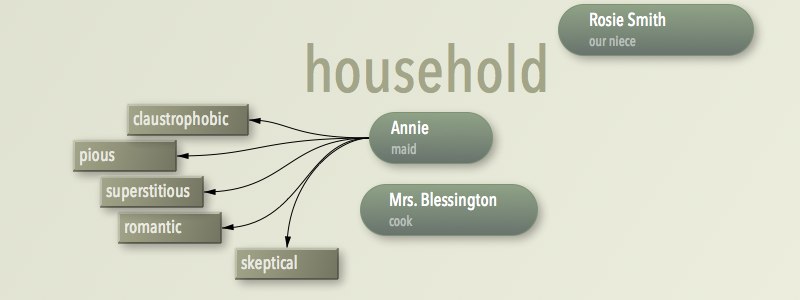What We’re Doing
Part 2 of an online seminar on Tinderbox and World Building for fiction and creative nonfiction. Join us! Email questions and suggestions to Mark Bernstein.

In this seminar, we’re going to explore some ways to build a rich and deep collection of notes concerning an imagined world. That world might be notionally real, if we’re writing history or creative nonfiction, or it might be entirely imaginary.
Ultimately, these notes will be a writing reference. In time, they might come to serve other purposes as well — a series bible, say, or the background for a screen adaptation. Indeed, as we begin these notes, we might not yet know whether we’re writing a story or a novella, a feature film, or a computer game. That’s why they call it “writing”
We could write these notes on small bits of paper, envelopes and napkins. We could write them in notebooks. We could type them into a word processor. We could carry them around in our head, hoping not to forget them.
The point of putting these notes into Tinderbox is, simply, to help us discover structure and to make connections. There are always too many things to remember; the more you write down, and the more confident you are that your notes will remind you about what you will need to know, the more concentration you can expend on more important things.
Tinderbox gives you lots of routes to discovering things you need to know, when you need them. We have maps and outlines and lists. Some of those lists can be agents that update and organize themselves for us. We have fast and flexible searching. We can even arrange for a changing document to reorganize itself as it grows. We’ll be talking about that soon, but for the moment, the crucial step is simply this: write stuff down.
It’s easy to forget details, especially obvious details that aren’t especially interesting. Let’s look at Annie, the maid. She’s an important asset, but she’s also going to be a lot of trouble. For the moment, we’ll give her some quirks and traits that might grow into a character:
- deeply romantic, but also deeply skeptical of human nature – especially of men
- both pious and superstitious
- claustrophobic
If we’re going to use these traits, we need to establish them first. And, if we’re going to go to the trouble of establishing them, economy suggests that we use them.
You already know this. Everyone knows this. But there’s lots to do, and you know you’re going to establish the claustrophobia, but with one thing and another you don’t actually get that down on the page before you workshop the rough draft of that part of the story. As a result, nobody looks at anything interesting or suggests anything you can use; the workshop spends twenty minutes haranguing you on the importance of locking your maid in the scullery sooner.
And maybe it turns out that you don’t need the claustrophobia. Fine: don’t use it. You’ve still got the note, and the maid is still unhappy about small closed spaces. It’s good to know. Perhaps you’ll need it for the sequel.
Notice that characters have one kind of appearance, and traits have a different appearance. Choosing distinct visual characteristics helps keep your map legible and pleasant to use. Subtle colors and quiet shapes can be more effective here than more emphatic choices; not every distinction should shout at you.
MORAL: Add depth by assigning speculative traits to people and places. You can revise them later, as needed, and you need not describe everything that you happen to know about each character. Use links to keep characters connected to their characteristic traits.
Questions? Alternatives? Corrections? Improvements to the story? Join the conversation: email bernstein@eastgate.com . We'll be back in a day or two with part three, in which I plan to talk about Tinderbox Prototypes.
Try Tinderbox
for Mac OS X ❧ More download options.
Buy Tinderbox
Tinderbox for you, for your team, or your enterprise. Plus upgrades, The Tinderbox Way, and more. Order here.